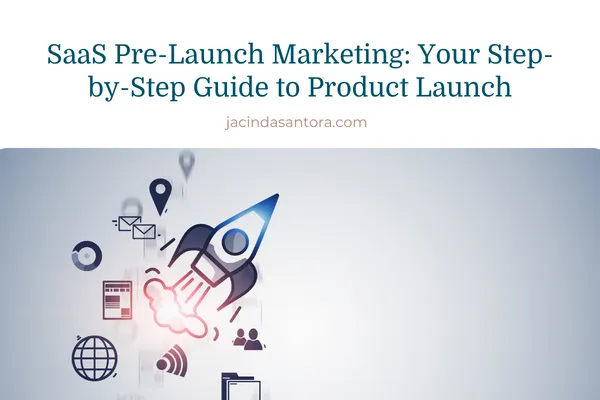



SaaS Pre-Launch Marketing Checklist
From the moment you first come up with an idea for your SaaS product, you need to think about marketing. It’s part of everything — from your brand’s personality to the features you talk about to what you’re going to name your product. That’s why it’s so important to focus on SaaS pre-launch marketing!
I know that it’s fun to think that you can dive right in and start selling. Hell, you might even see some success with that method. But you’re going to set yourself up for greater (and sustainable) success if you put in some effort on building an SaaS pre-launch marketing strategy.
In this article, I’m going to walk you through an 10-point checklist for SaaS pre-launch marketing so you can get your idea off the ground quickly and achieve the results you want. I’m super excited and I hope you are too — let’s dive in!
SaaS Pre-Launch Marketing Checklist
Marketing your SaaS product is about more than just getting to market. If you’re introducing a new technology, you’ll need to take the time to educate and nurture your target audience. If you’re introducing a new product with competitors, you’ll need to convince your target audience that your product is worth a look.
Your pre-launch marketing can help with a lot of the issues SaaS businesses have when bringing a new product to market. This might mean establishing yourself as an authority in your niche, using content marketing to educate your audience, and utilizing SEO to get your product and brand found in search results.
So, let’s talk about…
How to Launch a SaaS Product
It’s likely that you’re going to be introducing your new SaaS product into a market that already includes businesses like yours that are better established and have revenue to spend on marketing.
That makes it even more important for you to stand out. And SaaS pre-launch marketing is how you make that happen.
Here are the 10 steps I recommend for your SaaS product launch plan.
1. Define Your Target Audience
Every product has a target audience and it’s vital to your product’s success to know that audience inside and out. This means learning about your target audience continually. You don’t want to just address their pain points at a static point in time, but be able to address their pain points as they grow and evolve.
If you’re an established company launching a new product, you can survey your current customer base to get information about their pain points. For brand new businesses, you’ll need to do a bit more legwork to define your target audience. Consider who will benefit most from your product. How old are they? What education background do they have? Where do they live? What kind of spending power do they have? What are their consumption habits?
2. Check Out Your Competitors
I’m a strong proponent of spying on your competitors. A competitor analysis can help you understand what your competitors are doing, where they’re excelling, where they’re failing, and what gaps there are in the products, services, and features your competitors offer.
From there, you’ll be able to build your own marketing plan to be bigger, better, and more targeted so you learn from their mistakes and get better results.
Related Content: Common Launch Marketing Mistakes (And How to Fix Them)
3. Build a Pre-Launch Landing Page or Website
Even before you launch your product, you’ll want to start growing your email list and getting potential customers excited about your product. Landing pages are one of the best ways to do this. I recommend creating a complete funnel with ads, a landing page, and pre-launch emails to nurture your leads. If you’re interested, I can help you build your funnel!
In addition to a lead generation landing page, you’ll want to start building your website. Remember a few years ago when everyone thought that websites were going to be obsolete in a few years’ time because of Facebook’s Pages? Yeah, that didn’t happen. You need a website to build your brand, share your story, and build your list.
4. Start a Blog
Blogging is one of the most effective ways to generate traffic to your website, establish yourself as an authority in your niche, and increase brand awareness. I firmly believe that every business should have a blog that contains a combination of valuable content that asks nothing of your audience and promotional content that gently drives your audience deeper into your funnel.
With your blog, you can show how your product addresses and solves the pain points that your target customers are experiencing. They get valuable and useful information and a little spiel about how they can do everything better and faster by becoming a customer.
5. Get Started With Email Marketing
Email marketing has the best ROI of any other marketing channel. Depending on the studies you read, you’ll find email marketing’s potential ROI listed as 3500–4400%. That means for every $1 you spend on email marketing, you have the potential to get back $35–$44.
That’s huge.
There’s really no reason NOT to do email marketing. It gives you the chance to connect with your customers and potential customers on a more personal level, share important information, promote your products and services, drive traffic to your website, and a lot more.
If you’re looking for an email marketing platform to streamline your email marketing, I use and recommend ConvertKit.
6. Start Collecting Leads
Once you have your landing page in place, you’ll start to collect leads. This is a great time to set up email automation and segmenting your email list so you can keep your emails highly targeted. You might even offer up positions in a beta testing group, free trials, or other ways to keep your list engaged and interested.
The goal is to start building your email list so you have an audience ready to go when you are.
7. Nurture Your Leads
As you build your email list, you’re going to want to start nurturing those leads right away. As soon as you have a single subscriber, it’s time to start nurturing. Consider how the leads came to you as well as other segments to send emails that will resonate with specific subscribers and keep them interested throughout your pre-launch.
It’s also a great time to start building out your customer onboarding email series. You want to make it as easy as possible for new users to get started with your product and on their way to seeing results.
8. Test and Gather Feedback
User testing is one of the best ways to find out if your product is viable before you spend tons of money building out an entire system and marketing it. Consider setting up focus groups of people within your target audience to test out your product and provide feedback. This will help you produce a better product that is more user-friendly and really hits the pain points of your target audience.
9. Set Up Analytics
I love analytics. Analytics give you important information about your product’s performance (and the performance of your marketing campaigns for the product). Google has quite a few tools that make analytics a breeze. I use Google Analytics and Google Tag Manager for most of my analytics needs (both are free).
10. Launch Your Product
Now it’s time to launch your product. By now, if you’ve followed the steps above, you should have an email list filled with engaged potential customers who are just waiting for your cart to open. You’ll turn off your landing pages and open up your website officially (preferably with tons of blog content on it).
While you’re at it, why not send a promotional email series announcing your launch and offering your subscribers a special discount for being with you right from the beginning?
Use Pre-Launch Marketing for a Successful SaaS Business
Launching a SaaS product can be difficult, even if you’ve done it before. This SaaS pre-launch marketing checklist will help keep you organized and keep the process streamlined.
And don’t forget, I’m here to help you out for all of your marketing needs. Contact me and let’s get this party started!
Nothing in on this page or any other site or communication by or from me is a promise of earnings or guarantee of results.
